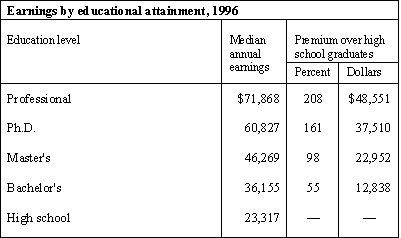An official website of the United States government
 United States Department of Labor
United States Department of Labor
Workers with a bachelor's, master's, doctoral, or professional degree generally have higher incomes than do workers with less education. In 1996, college graduates earned nearly 75 percent more than high school graduates. Median annual earnings for all college graduates were $40,753, compared with $23,317 for all high school graduates.

[Chart data—TXT]
A " diploma premium" is attached to each advanced educational level. Employees with bachelor's degrees earned $36,155—55 percent more than high school graduates. Employees with masters’ degrees earned 28 percent more than bachelors’ degree holders and workers with Ph.Ds earned 31 percent more than those with masters’ degrees. Those workers with professional degrees such as medicine or law had the highest median earnings at $71,868, a level 18 percent above the median earnings of workers with Ph.Ds.
The additional earnings associated with a professional degree represented nearly a 100-percent increase over the average earnings for those with a bachelor's degree and a 208-percent premium over the earnings of high school graduates.
These data are a product of the Current Population Survey. More information may be obtained from "Earnings of College Graduates, 1996", Occupational Outlook Quarterly, Fall 1998.
Bureau of Labor Statistics, U.S. Department of Labor, The Economics Daily, Earnings increase substantially with additional education at https://www.bls.gov/opub/ted/1998/oct/wk3/art05.htm (visited November 03, 2025).

